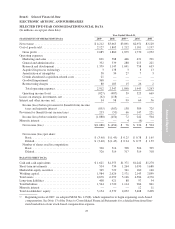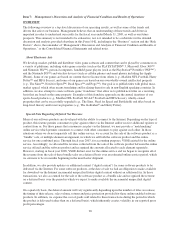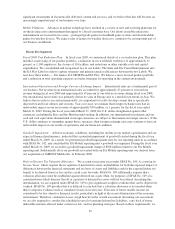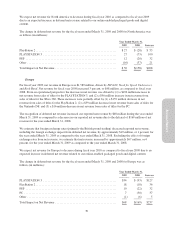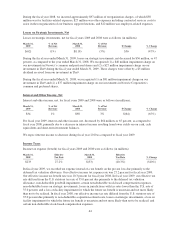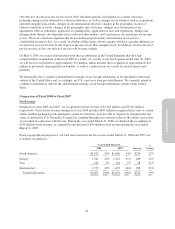Electronic Arts 2009 Annual Report Download - page 115
Download and view the complete annual report
Please find page 115 of the 2009 Electronic Arts annual report below. You can navigate through the pages in the report by either clicking on the pages listed below, or by using the keyword search tool below to find specific information within the annual report.
Annual Report
Assessment of Inventory Obsolescence. We regularly review inventory quantities on-hand and in the retail
channel. We write down inventory based on excess or obsolete inventories determined primarily by future
anticipated demand for our products. Inventory write-downs are measured as the difference between the cost of
the inventory and market value, based upon assumptions about future demand that are inherently difficult to
assess. At the point of a loss recognition, a new, lower cost basis for that inventory is established, and subsequent
changes in facts and circumstances do not result in the restoration or increase in that newly established cost basis.
Stock-Based Compensation
We are required to estimate the fair value of share-based payment awards on the date of grant. The estimated fair
value of stock options and stock purchase rights granted pursuant to our employee stock purchase plan is
determined using the Black-Scholes valuation model which requires us to make certain assumptions about the
future. Determining the estimated fair value is affected by our stock price as well as assumptions regarding
subjective and complex variables such as expected employee exercise behavior and our expected stock price
volatility over the term of the award. We estimated the following key assumptions for the Black-Scholes
valuation calculation:
•Risk-free interest rate. The risk-free interest rate is based on U.S. Treasury yields in effect at the time of
grant for the expected term of the option.
•Expected volatility. We use a combination of historical stock price volatility and implied volatility
computed based on the price of options publicly traded on our common stock for our expected volatility
assumption.
•Expected term. The expected term represents the weighted-average period the stock options are
expected to remain outstanding. The expected term is determined based on historical exercise behavior,
post-vesting termination patterns, options outstanding and future expected exercise behavior.
•Expected dividends.
Changes to our underlying stock price, our assumptions used in the Black-Scholes option valuation calculation
and our forfeiture rate, which is based on historical data, as well as future equity granted or assumed through
acquisitions could significantly impact compensation expense to be recognized in future periods.
Royalties and Licenses
Our royalty expenses consist of payments to (1) content licensors, (2) independent software developers, and
(3) co-publishing and distribution affiliates. License royalties consist of payments made to celebrities,
professional sports organizations, movie studios and other organizations for our use of their trademarks,
copyrights, personal publicity rights, content and/or other intellectual property. Royalty payments to independent
software developers are payments for the development of intellectual property related to our games.
Co-publishing and distribution royalties are payments made to third parties for the delivery of product.
Royalty-based obligations with content licensors and distribution affiliates are either paid in advance and
capitalized as prepaid royalties or are accrued as incurred and subsequently paid. These royalty-based obligations
are generally expensed to cost of goods sold generally at the greater of the contractual rate or an effective royalty
rate based on the total projected net revenue. Significant judgment is required to estimate the effective royalty
rate for a particular contract. Because the computation of effective royalty rates requires us to project future
revenue, it is inherently subjective as our future revenue projections must anticipate a number of factors,
including (1) the total number of titles subject to the contract, (2) the timing of the release of these titles, (3) the
number of software units we expect to sell, which can be impacted by a number of variables, including product
quality, the timing of the title’s release and competition, and (4) future pricing. Determining the effective royalty
rate for our titles is particularly challenging due to the inherent difficulty in predicting the popularity of
entertainment products. Accordingly, if our future revenue projections change, our effective royalty rates would
change, which could impact the amount and timing of royalty expense we recognize.
35




